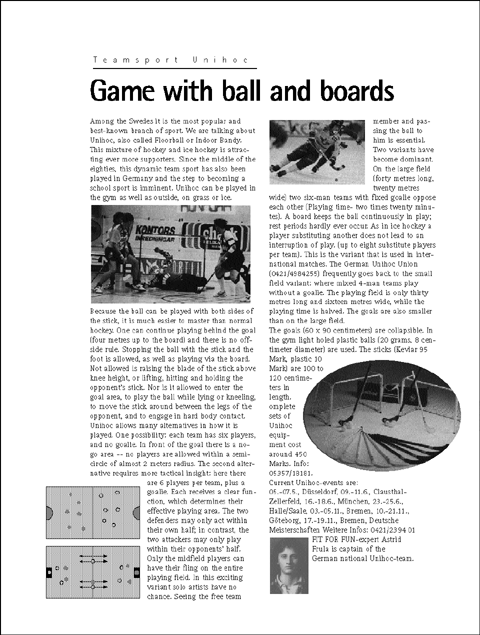 Figure 1: First example layout of the Unihoc page
Figure 1: First example layout of the Unihoc page
 Figure 1: First example layout of the Unihoc page
Figure 1: First example layout of the Unihoc page
The first example contains no layout decisions that would subdivide the text into segments and establish relations among these segments - despite the fact that the text organisation in terms of RST (see below) contains many such segments and relations. The only subdivisions used in this example are the heading and the paragraph divisions. This example has only been added for comparison.
Figure 2: Second example layout of the Unihoc page
In example 2 a relatively large number of layout decisions is taken to structure the article. For instance, the most important statements form a block of their own at the top of the page, additional information is placed in a vertical grey bar, the main text is divided in two sections "The rules" and "Unihoc variants". We believe that this layout fullfills the tasks (set out in the introduction) reasonably well.
Figure 3: Third example layout of the Unihoc page
Example 3 shows that achieving an overview of the article is not necessarily supported by the arbitrary application of layout measures. Among the unmotivated decisions that make this layout incomprehensible are: the "variants" section breaks down into two parts of different visual appearance, additional information (events) becomes erroneously important due to its prominent position and font size, the information about the author is related only to the first textblock and not to the entire article. The problem this raises is identical to any generation task once more flexibility of expression/presentation is made available, it is essential to appropriately control this flexibility in order to avoid wrong decisions.


Figure 4: In the different resolutions we see how words gradually blend into lines, lines into blocks etc. The labeling of the main components (A, B, C) is referred to in figure 5.
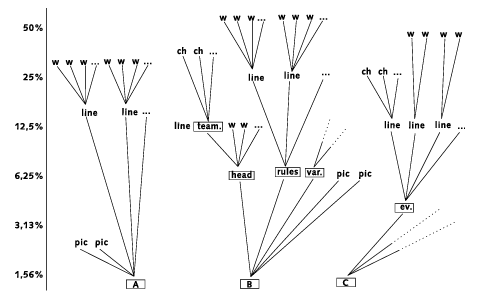
Figure 5: The hierarchy imposed by visual grouping taking parts of the example layout number 2 as an example (pic = picture, w = word, ch = character).
This grouping is represented schematically in figure 5. The diagram can be read as follows: The vertical axis shows the progressive reduction of the page resolution. The placement of an element along this axis indicates that from this resolution on downwards its subelements cannot be distinguished anymore. The lower such a point lies, the higher the resolution-reduction must be for blending its children into one element, i.e. the more prominent these children are. The depth of two elements with regard to their next common root indicates the strength of their visual coherence. We assume that the strength of visual coherence is proportional to the strength of rhetorical coherence.
Finally, the legibility of an element corresponds to the minimal resolution at
which the text is still readable, which is more or less the resolution where
the single characters just blend into words. Obviously, this depends mainly on
the type size.
An increase of prominence as well as legibility also means an increase of the space required (free space, additional graphical elements, larger fonts etc.). The attribution of prominence and legibility to elements is a decision which up to a certain point can also have a formal aesthetic motivation. However, it basically has to reflect the intrinsic or rhetorical importance of the elements for the achievement of the goal of the entire group, which we call communicative significance. That means, given the same amount of text, a more significant element may use up more space, either through its own size or through the amount of space around it (For instance, in the headline group of example 2, the "subheadline" "Teamsport Unihoc" has only a small communicative significance compared to the main headline but the same amount of text. Visually, it seems to be only an appendage to it). The ratio of communicative significance to amount of text is called communicative effectiveness. Differences in communicative effectiveness lead to different types of text elements with different prominence and legibility values.
However other cases exist in which one would like to distinguish between different text types without falling back on a difference in communicative effectiveness. An example: The author segment and the events segment have been attributed different types. The communicative effectiveness however - being an instrument for explaining the different treatment of elements on the same levels forming one group - cannot account for this difference just like that. Consequently, we would need to extend this instrument for the comparison of elements that do not satisfy the above conditions. However, even the introduction of an overall
effectiveness1 would not justify the difference in type between the author segment and the events segment, since it is practically equal for both segments. There has to be an additional reason for type distinction. This becomes even clearer if we consider the example of a multi-column page of a multilingual edition where each column contains the same text but in a different language. Here all texts obviously have the same communicative effectiveness, nevertheless they may be attributed different types.
Another interesting issue is reading order: the Latin alphabet imposes a left-to-right and top-to-bottom reading order. However, this default reading order is only defined on columns of text. Consequently, it is only valid within groups, for instance in the "The rules" group of our example. Among groups, the reading order is a result of the interaction between depth of embedding, visual prominence and the default reading order. In this layout the most likely starting points are the beginning of the bold paragraph at the top of the page "Among the Swedes..." and the headline "Game with ball and boards".
From this discussion we see that the main goal of the layout, to provide an
overview over the document, is mainly realised through three subgoals:
grouping, type distinction and reading order. In the following graph the three
subgoals are represented as relations between the elements of the Unihoc example. This representation containing also the communicative effectiveness
of the elements, we call layout structure (henceforth LS).
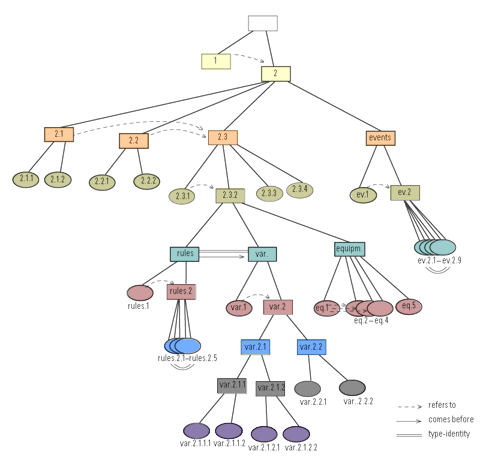
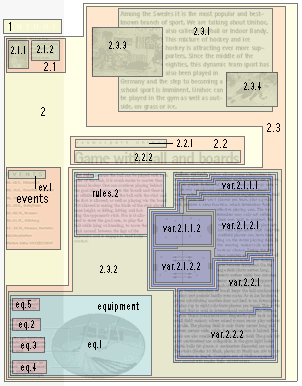 Figure 6 a+b: Layout Structure of the Unihoc article (effectiveness values have been omitted)
Figure 6 a+b: Layout Structure of the Unihoc article (effectiveness values have been omitted)
So far we have presented a layout description on a high level, that is through layout goals represented in the LS. It seems plausible that these goals can lead to a layout similar to example 2. Moreover it appears that these layout goals reflect up to a certain point the rhetorical organisation of the text. Since both assumptions only are based on the intuitive analyis of example 2, they require further generalisation and formalisation. That is why on the one hand we need to ask the question how these goals can be sensibly realised, on the other hand how they are formally motivated.
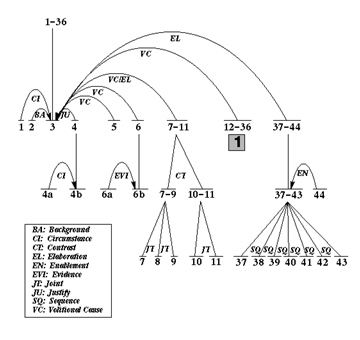
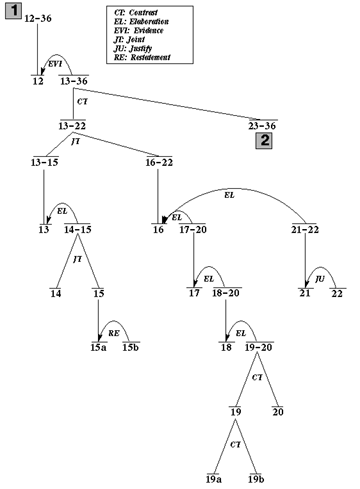
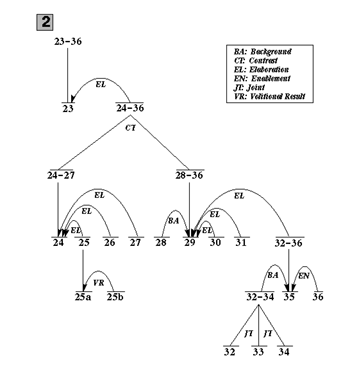
Figure 7: RST structure of the Unihoc text
This is graphically depicted in figure 7 (where [4b] is the nucleus and [4a] the satellite and ci stands for the relation which relates them). A nucleus can not be ommitted from the text without endangering the text's coherence, whereas a satellite can. If a relation holds between text segments of equal importance it is called multinuclear (for instance the joint relation between [10] and [11] in figure A5). A definition of a RST relation typically consists of the following elements: the name of the relation; the constraints on the nucleus, on the satellite and on their combination; the effect of the relation and the locus of this effect. The definition in table 1 taken from Mann and Thompson (1987) will illustrate this.
RST relation name: condition
constraints on N: none constraints on S: S presents a hypothetical, future, or otherwise unrealized situation (relative to the situational context of S) constraints on N+S combination: Realization of the situation presented in N depends on realization of that presented in S. the effect: Reader recognizes how the realization of the situation presented in N depends on the realization of the situation presented in S. locus of the effect: N and S
Table 1: definition of RST relation
The structure in figure 7 also shows that RST is recursive:
nuclei and satellites themselves may also be RST structures. There are neither
constraints on the order of the nucleus and the satellites, nor on the number
of satellites a nucleus may have. Metainformation as required by the layout is
usually not formulated directly in the form of a rhetorical relation, with the
exception of the summary relation. For that reason a transformation of RST
relations into the layout structure is not straightforward, but has to be done
through the analysis of the RST structure.
This is for instance the case in unit A of example 2 in which a kind of summary
of the document is made available to the reader. The contents of this summary
are neither related to the rest of the text in the RST structure by means of
the summary relation, nor are they explicitly represented as a coherent text
unit, in which case it would be either a satellite or a nucleus. Our hypothesis
is rather that this unit is composed of the summary of most important
statements on the central theme. These statements can be found by gathering
branches in the RST structure until a certain volume has been reached. These
branches must not be too deeply embedded which means that the root of the
branch has to be directly connected to the root nucleus - which may be included
as well - on a high level. Another example are the events which express a form
of additional information on the central theme. Our hypothesis is that if this
information has only a limited outflow (no or little other information is
dependent on it) or if it has a distinct and/or regular structure it is a
likely candidate for a separate layout item. It is to be expected that a large
part of the layout goals can be inferred from RST by means of a structural
analysis. Additional information
is required to determine the layout goals completely and thus enable the
transformation of the RST structure into the layout structure. For instance, RST ignores headlines completely, whereas they are essential in the layout structure. To overcome this problem, headlines should be generated from suitable text elements identified by the RST structure. Theme analysis could play an important role in this headline generation. It can also be helpful in another field: thematic
dependencies can constrain the reading order of elements and thus determine
layout goals.
constraint group order type
sim.
closeness +++
alignment +++ + +
same width + ++
same height + ++
same shape + - ++
same texture ++ - - +++
equally marked + - - ++
before/after - +++
overlap ++ ++ -
same layer + - - +
same area +++ +++
Table 2: Use of the graphical and typographical resources for the different layout goals
The interdependence of the layout goals as well as the overlaps in the
assignment of layout goals to graphical resources indicate that normally many
different layouts will exist which are functionally similar and that any
process of automatically transforming the layout goals into an actual layout is
very complex.
Some characteristics and components of such a process can already be
identified. It will have to take into account the fact that layout is not
solely determined by constraints as regards the content to be communicated to
the reader, the so-called communicative goal, but also by constraints
concerning the content-independent outward appearance (the presentational
goals). For instance, a magazine can have its own typical "look" fixed in style
guides, which may constrain the choice of type faces, colours, etc. In most
cases, including most magazine articles, the construction of layout goals and
the search for the best realisation only has to be done on a relatively high
level. The fact is, the layout goals and means for the realisation of elements
smaller than those identified in the LS - e.g. paragraphs, lines, words, letters -
are largely determined by the conventions of microtypography (Hochuli 1987).
One component for automatically realising layouts will most likely be a
resource allocation process that solves the conflicts among the layout goals
competing for resources and finds an optimal combination. A further special
problem arises from the fact that, although many of the resources from table 2
constrain positioning, they do not determine it completely.
In the area of page layout a number of specific layout strategies are commonly
used, each offering a mechanism for the concrete spatial distribution of the
layout elements. These strategies range from "free" positioning (employed in
our example 2) over grid-based positioning to the linear filling of columns
(used in example layout 1). A preselection from the graphical resources comes along with the
spatial distribution mechanism in most strategies. For example, the only
resources that the filling of columns leaves to pick from, are texture, marks
and colored areas. All positioning-related resources are either occupied by
that strategy or incompatible with it.
Two international standards in the area of layout, FOSI (1990) and DSSSL (1994)
are based on this strategy. They both provide a language to model the behaviour
of sgml-marked text in all possible situations that may occur during the
filling of columns. The only work known to us that takes into account other
spatial distribution strategies is the one of Weitzman and Wittenburg (1994).
Here, the distribution strategy for each layout is given through the set of
constraints - somewhat more concrete than our resources - that is applied to
the elements in the given case. The application of the constraints is driven by
manually generated rules, their realisation is done by a constraint-solving
process.
Appendix The example text
[1] Among the Swedes it is the most popular and best-known branch of sport. [2] We are talking about Unihoc, also called Floorball or Indoor Bandy. [3] This mixture of hockey and ice hockey is attracting ever more supporters. [4a] Since the middle of the eighties, this dynamic team sport has also been played in Germany and [4b] the step to becoming a school sport is imminent. [5] Unihoc can be played in the gym as well as outside, on grass or ice. [6a] Because the ball can be played with both sides of the stick, [6b] it is much easier to master than normal hockey. [7] One can continue playing behind the goal (four metres up to the board) and [8] there is no offside rule. [9] Stopping the ball with the stick and the foot is allowed, as well as playing via the board. [10] Not allowed is raising the blade of the stick above knee height, or lifting, hitting and holding the opponent's stick. [11] Nor is it allowed to enter the goal area, to play the ball while lying or kneeling, to move the stick around between the legs of the opponent, and to engage in hard body contact. [12] Unihoc allows many alternatives in how it is played. [13] One possibility: [14] each team has six players, and no goalie. [15a] In front of the goal there is a no-go area - [15b] no players are allowed within a semicircle of almost 2 meters radius. [16] The second alternative requires more tactical insight: [17] here there are 6 players per team, plus a goalie. [18] Each receives a clear function, which determines their effective playing area. [19a] The two defenders may only act within their own half; [19b] in contrast, the two attackers may only play within their opponents' half. [20] Only the midfield players can have their fling on the entire playing field. [21] In this exciting variant solo artists have no chance. [22] Seeing the free team member and passing the ball to him is essential. [23] Two variants have become dominant. [24] On the large field (forty metres long, twenty metres wide) two six-man teams with fixed goalie oppose each other (Playing time- two times twenty minutes). [25a] A board keeps the ball continuously in play; [25b] rest periods hardly ever occur. [26] As in ice hockey a player substituting another does not lead to an interruption of play. (up to eight substitute players per team). [27] This is the variant that is used in international matches. [28] The German Unihoc Union (0421/4984255) frequently goes back to the small field variant: [29] where mixed 4-man teams play without a goalie. [30] The playing field is only thirty metres long and sixteen metres wide, while the playing time is halved. [31] The goals are also smaller than on the large field. [32] The goals (60 x 90 centimeters) are collapsible. [33] In the gym light holed plastic balls (20 grams, 8 centimeter diameter) are used. [34] The sticks (Kevlar 95 Mark, plastic 10 Mark) are 100 to 120 centimeters in length. [35] Complete sets of Unihoc equipment cost around 450 Marks. [36] Info: 05357/18181. [37] 05.-07.5., Düsseldorf, [38] 09.-11.6., Clausthal-Zellerfeld, [39] 16.-18.6., München, [40] 23.-25.6., Halle/Saale, [41] 03.-05.11., Bremen, [42] 10.-21.11., Göteborg, [43] 17.-19.11., Bremen, Deutsche Meisterschaften. [44] Weitere Infos: 0421/23 94 01
